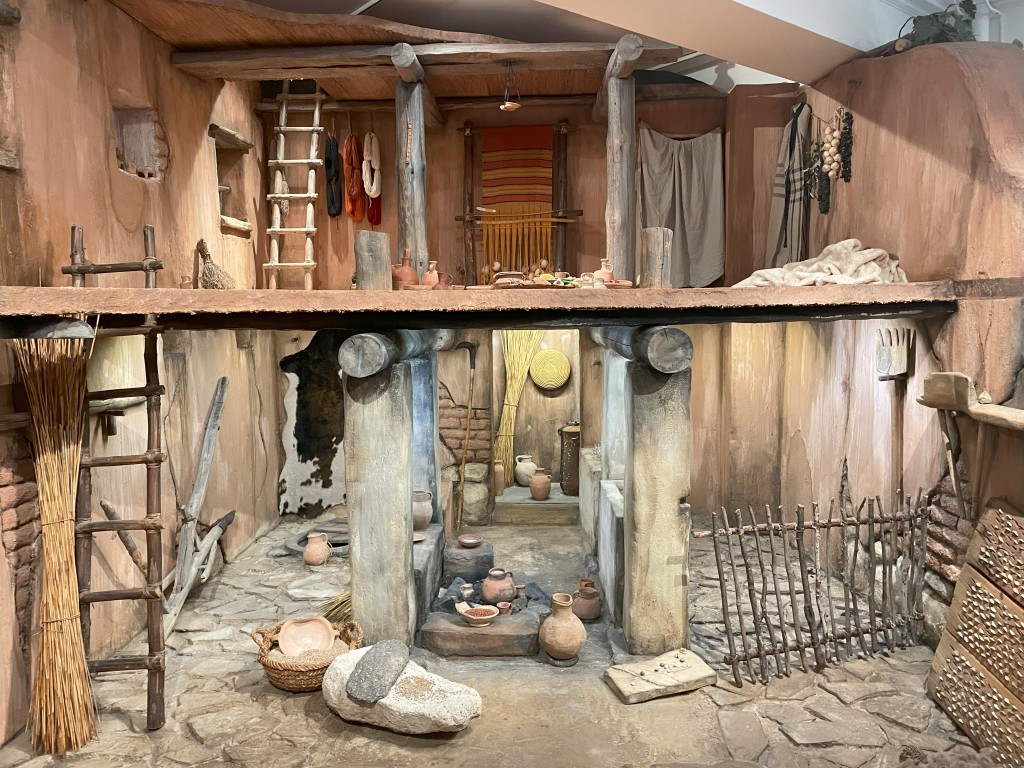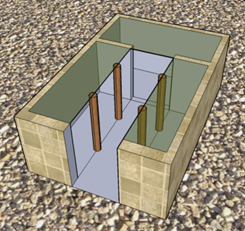
The four-room house is a distinctive architectural feature of ancient Israel, emerging during Iron Age I and becoming emblematic of Israelite culture until the Babylonian exile. This design has sparked considerable debate among scholars regarding its origins and cultural significance. Was it an Israelite invention, or did it evolve from broader regional influences?
I recently visited the Harvard Musem of the Ancient Near East in Boston. Taking pride of place in the exhibits is a full-scale model of a four-room house. This provides a real feel for how families lived in ancient Israel during the Old Testament monarchy period. The reconstruction shows the agricultural endeavours of the typical home. The ground floor has space for animals, stores for food and various equipment like a threshing sled on the bottom right. Upstairs are the sleeping quarters – with rooms separated off by hanging curtains. You can also see a ladder providing access the roof.
The four-room house is a regular feature of archaeological sites in Israel. The style suddenly appeared in early Iron Age 1 in the central Judean highlands. This has led to some scholars claiming it was an Israelite invention[1] and hence stands as a marker for the arrival of the Israelites in the land. However as noted by the New Encyclopedia of Archaeological Excavations in the Holy Land this conclusion of it being an Israelite invention is not unanimous but rather an open question[2] (see also Fritz 2005[3]). Regardless, the design has rightly become a hallmark of Israelite culture until the exile and to some at least, highly suggestive of the emergence of a new culture in Cana around the time of the exodus.
Debate on Origins – is the 4-room house Israelite?
Mazar provides a conservative summary of the origin of the design as follows:
The pillared-house type is regarded by some as having developed among Israelite tribes who settled in the central hill country and in the northern Negev. Some scholars have even suggested that this type evolved from the pastoralist’s tent. It is not, however, limited to the Israelite settlement sites…pillared houses were the building fashion of the period—possibly rooted in the domestic architecture of southern Canaan in the Late Bronze Age, but eventually adopted by all the peoples living in Palestine during Iron Age I. Among the Israelites inhabiting the central hill country and the northern Negev, this type of house became the most popular form; later, in the period of the Monarchy, it became a hallmark of Israelite domestic architecture.[4]
As Mazar notes there are some (though actually quite limited!) examples of the four room house design outside of areas traditionally associated with Israelite control (like Gezer and ancient Moab). Because of the strong association of this design with Israelite society in the time of the kings the spread of the houses is considered evidence of the movement of Israelites or imitation by neighbours[5],[6].
The minimalist school represented by scholars like Israel Finkelstein, objects to strong links between the four room house and the Israelites. Mazar’s non-committal position reflects the influence of this school. However in contrast to this Avraham Faust and Shlomo Bunimovitz make the following points in support of a close connection between the Israelites and the four room house[7]:
- The design is predominantly found in Israel (where it is nearly ubiquitous)
- The limited external examples are regions which conceivably were influenced by Israel and vary somewhat from the normal design
- The design appears around the 13th century and then disappears at the time of Judean exile. This termination of the design strongly supports a connection to the ethnic identity of Israel. If the design was just a great design it should have continued among non-Jewish populations.
Use and configuration
Pioske (2013) has a model reconstruction of the four bedroom house[8] and notes that animals were kept on the ground floor while people slept on the second floor. In his view the 4-room house was well suited to a predominantly agrarian society, which characterised Israel throughout the monarchy period.

While there are some differences noted between individual houses there is far more similarity. Contrary to perhaps modern expectations houses weren’t seemingly used to display disparate wealth as Faust notes:
There is no evidence for socioeconomic stratification in the villages. An analysis of the dwellings, seemingly the best indicator of socioeconomic stratification (Smith et al. 1989; Blanton 1994; Faust 1999, and there a bibliography), does not demonstrate any significant differences, either in area or in plan and quality. The similarity is not only evident among the houses in each village (intrasite), but usually also among the villages (intersite).[9]
Faust (2000) notes as it relates to size the primary difference between homes is whether they are urban or rural. Urban houses range from 30 to 70sm leading scholars to think the primary unit in cities was a nuclear family. In rural areas the house sites are closer to 120sqm suggesting each house may have held multiple generations[10].
Faust (2016) [11] also notes the emergence and rapid dominance of the 4 room house as “the house” fits well with a culture that valued ‘the right way’ and order. The flexible upper living area allowed for reconfiguration and with access to all rooms from the centre made compliance with purity related segregation rules easier than older Canaanite dwellings where access was linear though a series of rooms. The design clearly worked for Israelites, reflecting their needs and ideals in a way which differed to other populations – hence the design fell abruptly out of favour when the Judean kingdom fell to the Babylonians.
Conclusion
Ultimately, the four-room house stands as a testament to the architectural ingenuity and cultural identity of ancient Israel. Its emergence and disappearance align closely with Israelite history. The design itself appears to reflect the social and religious values of its builders.
While some debate remains, it seems the design provides good early evidence for the early distinct existence of Israel. Models of the home style help use better imagine life in Old Testament times.
by Daniel Edgecombe
[1] Shiloh, Yigal. “The Four Room House. Its Situation and Function in the Israelite City.” Israel Exploration Journal 1970, Vol. 20 (3), pp: 180–190
[2] Ephraim Stern, ed., The New Encyclopedia of Archaeological Excavations in the Holy Land (New York; London; Sydney; Tokyo; Singapore; Toronto; Jerusalem: Israel Exploration Society & Carta; Simon & Schuster, 1993), 1537.
[3] V. Fritz, “Architecture,” ed. Bill T. Arnold and H. G. M. Williamson, Dictionary of the Old Testament: Historical Books (Downers Grove, IL: InterVarsity Press, 2005), 82.
[4] Amihai Mazar, Archaeology of the Land of the Bible 10,000-586 B.C.E. (New Haven; London: Yale University Press, 1990), 342–344.
[5] Ingrid M. Swinnen, “The Iron Age I Settlement and Its Residential Houses at Al-Lahun in Moab, Jordan,” Bulletin of the American Schools of Oriental Research (May), no. 354 (2009): 49.
[6] Steven Ortiz and Samuel Wolff, “Guarding the Border to Jerusalem: The Iron Age City of Gezer,” Near Eastern Archaeology 75, no. 1–4 (2012): 18.
[7] Avraham Faust and Shlomo Bunimovitz, “The Four Room House: Embodying Iron Age Israelite Society,” Near Eastern Archaeology 66, no. 1–4 (2003): 22–30.
[8] Daniel D. Pioske, “David’s Jerusalem: A Sense of Place,” Near Eastern Archaeology 76, no. 1 (2013): 11.
[9] Avraham Faust, “The Rural Community in Ancient Israel during Iron Age II,” Bulletin of the American Schools of Oriental Research (February), no. 317 (2000): 28.
[10] Avraham Faust, “The Rural Community in Ancient Israel during Iron Age II,” Bulletin of the American Schools of Oriental Research (February), no. 317 (2000): 19.
[11] Avraham Faust, The Emergence of Israel and Theories of Ethnogenesis, in The Wiley Blackwell Companion to Ancient Israel, First Edition. Edited by Susan Niditch. 2016 John Wiley & Sons, Ltd. Published 2016 by John Wiley & Sons, Ltd.page 166-167
